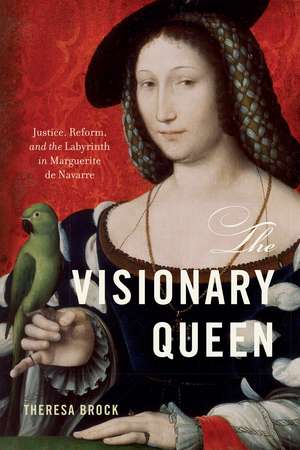The Visionary Queen – Justice, Reform, and the Labyrinth in Marguerite de Navarre
Autor Theresa Brocken Limba Engleză Hardback – 17 mar 2024
The Visionary Queen affirms Marguerite de Navarre’s status not only as a political figure, author, or proponent of nonschismatic reform but also as a visionary. In her life and writings, the queen of Navarre dissected the injustices that her society and its institutions perpetuated against women. We also see evidence that she used her literary texts, especially the Heptaméron, as an exploratory space in which to generate a creative vision for institutional reform. The Heptaméron’s approach to reform emerges from statistical analysis of the text’s seventy-two tales, which reveals new insights into trends within the work, including the different categories of wrongdoing by male, institutional representatives from the Church and aristocracy, as well as the varying responses to injustice that characters in the tales employ as they pursue reform. Throughout its chapters, The Visionary Queen foregrounds the trope of the labyrinth, a potent symbol in early modern Europe that encapsulated both the fallen world and redemption, two themes that underlie Marguerite's project of reform.
Preț: 895.47 lei
Preț vechi: 1088.05 lei
-18% Nou
Puncte Express: 1343
Preț estimativ în valută:
171.36€ • 181.03$ • 143.26£
171.36€ • 181.03$ • 143.26£
Carte nepublicată încă
Doresc să fiu notificat când acest titlu va fi disponibil:
Se trimite...
Preluare comenzi: 021 569.72.76
Specificații
ISBN-13: 9781644533277
ISBN-10: 1644533278
Pagini: 238
Ilustrații: none
Dimensiuni: 152 x 229 x 20 mm
Greutate: 0.07 kg
Editura: MW – Rutgers University Press
ISBN-10: 1644533278
Pagini: 238
Ilustrații: none
Dimensiuni: 152 x 229 x 20 mm
Greutate: 0.07 kg
Editura: MW – Rutgers University Press
Notă biografică
Theresa Brock is Assistant Professor of French Studies at Smith College. She received her PhD from Penn State and has published articles on women writers, literary genre, and religious studies in the early modern era, with particular emphasis on the sixteenth century.
Cuprins
Acknowledgments
Introduction. Marguerite de Navarre: The Visionary Queen
Part I: Labyrinthine Motifs in Marguerite’s Era, Endeavors, and Spiritual Outlook
1. The Labyrinth as Structure and Symbol: From Experience to Writing in the Medieval and Early Modern Contexts
2. From the Labyrinth, a Vision: Competing Influences on Marguerite’s Religious, Political, and Creative Endeavors
3. “We Walk by Faith, Not by Sight”: Exegesis, Pilgrimage, and Labyrinthine Connections in the Reformation
Part II: The Heptaméron as Textual Labyrinth
4. Into the Labyrinth: Mirroring Sin, Prompting Reform
5. Down Tortuous Paths: Exploring Approaches to Justice and Reform
6. Above the Labyrinth: A Higher Vision for Reforming the Self and Society
Conclusion. The Empirical Reader at Labyrinth’s End: Responding to Marguerite’s Vision
Notes
Bibliography
Index
Introduction. Marguerite de Navarre: The Visionary Queen
Part I: Labyrinthine Motifs in Marguerite’s Era, Endeavors, and Spiritual Outlook
1. The Labyrinth as Structure and Symbol: From Experience to Writing in the Medieval and Early Modern Contexts
2. From the Labyrinth, a Vision: Competing Influences on Marguerite’s Religious, Political, and Creative Endeavors
3. “We Walk by Faith, Not by Sight”: Exegesis, Pilgrimage, and Labyrinthine Connections in the Reformation
Part II: The Heptaméron as Textual Labyrinth
4. Into the Labyrinth: Mirroring Sin, Prompting Reform
5. Down Tortuous Paths: Exploring Approaches to Justice and Reform
6. Above the Labyrinth: A Higher Vision for Reforming the Self and Society
Conclusion. The Empirical Reader at Labyrinth’s End: Responding to Marguerite’s Vision
Notes
Bibliography
Index
Descriere
The Visionary Queen argues that sixteenth-century noblewoman Marguerite de Navarre is more than a French author, political figure, or non-schismatic religious reformer. She is a visionary, as demonstrated in her efforts to better society, especially for women, in her literary writings (notably the Heptaméron), in her writings’ responses to her male contemporaries, and in the symbolism of the labyrinth reflected in her life and works.
